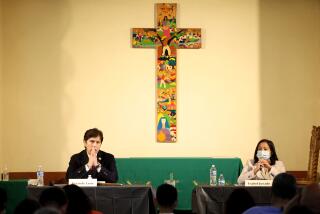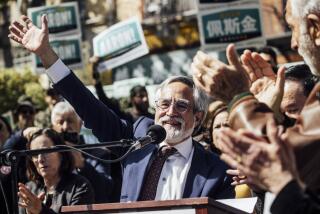Sewer Socialism
Not too long ago, U.S. elections were determined -- and sometimes stolen -- in cities. In the 21st century, however, the nation’s major urban areas have become largely politically peripheral, except as stages for national party conventions.
As a result, neither major party makes a serious effort to address the crises affecting U.S. cities -- dysfunctional school systems, a declining middle class, eroding employment and rising populations of mostly poor, new immigrants. Instead, cities are essentially a kept constituency of liberal Democrats whose idea of an urban policy, aside from patronage, increasingly revolves around cosmetic face-lifts and the arts.
Missing today from national and local agendas is anything remotely resembling the progressivism that spurred the successful evolution of U.S. cities in the last century. Sometimes dubbed “sewer socialism,” this program for development started at the municipal level and aimed to repair the legacy of the Industrial Revolution. From small, faded industrial cities like Bridgeport, Conn., to Los Angeles, enlightened administrations -- sometimes led by labor-oriented socialists, other times by business-oriented “progressives” -- cleaned up disease-ridden environments with new sanitation systems, created municipal-owned water and power systems, developed parks and upgraded education systems.
Cities’ political irrelevance stems partly from their diminishing share of the nation’s population and electorate. Fifty years ago, two in five Illinois voters lived in Chicago; today, fewer than one in five live there. New York City once contained half of New York state’s electorate, a proportion that has been cut to less than one-third. In 1952, 40% of Maryland voters lived in Baltimore; today the city is home to less than 10%.
As the urban electoral base has shrunk, city politics have become increasingly homogeneous. A generation ago, a Ronald Reagan or a Richard Nixon could contest for working- and middle-class voters on Chicago’s Northside, in the borough of Queens or in the San Fernando Valley. These areas today are so heavily Democratic that any national Republican effort to woo them would be virtually pointless. Most cities, says Brookings Institution demographer Bill Frey, have continued to lose middle-class, middle-aged, native-born Americans since 2000 -- the swing voters who supported reform-minded Republicans like Richard Riordan and Rudy Giuliani.
Cities’ declining political clout is reflected in the state of urban policy. The focus now is on what sociologist John Kasarda calls “visual prosperity” -- the attempt to dress up urban areas with fancy edifices, cultural attractions and high-end housing.
“Patronage aside, Democratic Party policy in the cities,” said Fred Siegel, professor of urban history at New York’s Cooper Union, “often boils down to how to attract the beautiful people.”
The policies of many of the brightest stars in the Democratic firmament -- Baltimore Mayor Martin O’Malley, Denver Mayor John W. Hickenlooper and Michigan Gov. Jennifer M. Granholm -- seem predicated on this beautiful-people principle. All emphasize the creation of cafe districts, arts entertainment and culture palaces as the best means to revive urban centers. In Los Angeles, Mayor James K. Hahn is similarly hitching his legacy to a $2-billion double feature for the leisure class -- the proposal for the ersatz Champs-Elysees on Grand Avenue and the glitzy LA Live project around Staples Center.
There is an alternative to the culture-and-arts approach to revive declining cities. It’s sewer socialism, a back-to-basics strategy that encourages business investment and the development of healthy neighborhoods.
Such an urban agenda has its origins in the early decades of the last century. In the West, it unfolded under the tutelage of business-oriented progressives who invested heavily in basic infrastructure -- public education, transit, water and power systems -- to encourage commerce and improve the living conditions for at least part of the middle and working classes. In Los Angeles, cheap water was brought to a dry city to benefit citizens and businesses. Nominally nonpartisan, but mostly Republican, city leaders fostered municipal ownership of utilities and worked to prevent the Southern Pacific Railroad from dominating the city’s new port. They also zoned to create a multipolar city to avoid the pitfalls of the traditional industrial one.
In the more industrialized Midwest and Northeast, the progressive impulse frequently took on a proletarian coloration. In places like Bridgeport, Milwaukee and, most remarkably, New York City under Fiorello LaGuardia, reformers were openly supported by socialists and leftist labor activists. The goal of their policies was to improve basic services and infrastructure for the vast majority of citizens, not just a designated elite.
Most important, politicians like LaGuardia and Emil Seidel, Milwaukee’s first socialist mayor, moved to overturn corrupt urban machines that primarily viewed the public purse as a means to reward friends and supporters. The progressive governments quickly earned a reputation for both frugal management and getting things done.
The working-class political base that supported sewer socialism, as well as the collectivist ideology that underpinned it, has largely evaporated. Yet, development-oriented urban politics are still relevant. To some extent, a variant of sewer socialism was practiced in Los Angeles during the 1980s when Mayor Tom Bradley united labor and corporate interests. Together, they pushed for the development of a job-creating infrastructure -- most notably at the airport and port complexes -- that help lay the foundation for the city’s ascendancy in the 1980s as the primary U.S. hub for Pacific Rim trade and commerce.
Such union leaders as the late Jim Wood of the Los Angeles County Federation of Labor essentially cut a deal with business: Unions would support huge publicly funded projects with broad economic goals as long as their members got to work on them. In turn, many of the jobs created in business services, at the port, in warehouses and at import-processing factories generated relatively well-paying private-sector jobs.
A more recent example of modern sewer socialism occurred in Houston under then-Mayor Bob Lanier. His administration focused on improving neighborhoods by enhancing public safety and constructing new roads, lighting and sewers, the groundwork for private sector-led economic development.
“You need to look at every neighborhood as your own and start from there,” Lanier explained after leaving office. “First, you bring back residents and then the commercial -- and jobs will come back. That’s what city governments should do. Play that role and things will happen on their own.”
Under Lanier’s administration, Houston rose from the wreckage of the 1980s oil bust to become one of the nation’s fastest-growing economies and demographically diverse cities.
Sewer socialism offers one possible direction out of the genteel, gradual decline that now threatens our cities. Any party or politician who embraces such a sensible, tried approach would deserve the grateful support of the beleaguered denizens of urban America.
More to Read
Get the L.A. Times Politics newsletter
Deeply reported insights into legislation, politics and policy from Sacramento, Washington and beyond. In your inbox three times per week.
You may occasionally receive promotional content from the Los Angeles Times.










